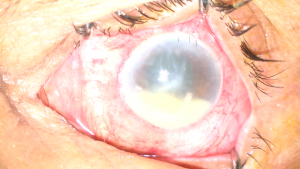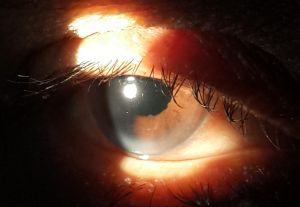Cataract is the clouding of the natural lens of the eye. The hitherto clear lens that allows light to pass through and focus a sharp image on to your retina, now becomes opacified, hindering the passage of light and hence debilitating your vision. Cataract surgery is removal of this opacified lens (cataract) and placement of an artificial lens, also known as intraocular lens (IOL) to restore your vision.
Though cataract surgery may sound scary, it is the most commonly performed procedure in the world. Recent improvements in technology also makes it the most successfully performed surgery in the world, even reducing the dependence on spectacles. Modern day cataract surgery uses the technique called phacoemulsification (phaco=lens emulsification=break into smaller pieces). Thus a phaco machine uses a high energy ultrasound probe to break the lens into smaller pieces within the eye through a microincision (approx 2mm) made in the cornea. These emulsified pieces are now sucked out of the eye by the phaco machine. Next an IOL is placed into your eye and routinely, the whole procedure does not last beyond 15 minutes.

In the best eye hospital, cataract surgery is a safe day care procedure with no need for overnight stay. Though the procedure itself is by and large safe, there is one dreaded complication called endophthalmitis. Endophthalmitis is an infection of the inside of the eye and when it occurs after surgery it is called post-operative endophthalmitis. Though endophthalmitis is a serious complication, its incidence is remarkably low, ranging from 0.02-0.71% in the world. This low incidence is thanks to the microincision cataract surgery techniques that have evolved in the recent past and have revolutionized the success rate of cataract surgery. Also, in an NABH accredited eye hospital like Neoretina where the operation theatres are equipped with air handling units (AHU) and strict sterilization and disinfection protocols are in place, the incidence of post cataract surgery endophthalmitis for our centre is zero so far.
However, apart from performing microincision phacoemulsification cataract surgery, installing AHU, giving 100% antibiotic prophylaxis to all our patients and following world-class sterilization and disinfection protocols to avoid endophthalmitis, there is still something better that we can do to avert this complication: that is, using an exclusive phaco pack during cataract surgery.


What is an exclusive phaco pack and what are its benefits?
Normally a reusable tubing set that comes with the phaco machine is sterilized with ethylene oxide sterilization and sealed for re-use. When you choose an exclusive pack, the surgeon opens a sealed, unused, disposable kit that contains the tubing set and manifold to be connected to the phaco machine. This ensures that your cataract surgery is 100% safe and it almost nullifies any chance of infection. The exclusive pack also includes a new viscoelastic gel that is used exclusively for you. This viscoelastic gel is important for keeping the anterior chamber of the eye formed during cataract surgery as well as for protection of important structures within the eye as phacoemulsification is being carried out.
The charges of this exclusive pack are not included in the cataract surgery package and the patient needs to pay extra for it. The amount payable seems negligible considering the safety it offers, especially in high risk patients like those who have only one seeing eye, diabetics who are at higher risk of infection than the general population and those with other systemic and ocular diseases which put them at a higher risk of infection. Choosing an exclusive pack is especially important in the times of coronavirus when we already know that Covid19 affects the eye and can even be transmitted through tears.
- Why Myopia Is Increasing Among School-Going Children – What Parents Should Know - December 10, 2025
- What Is an Eye Stroke? Causes, Symptoms, and Treatment Explained by Retina Specialists - December 10, 2025
- A Clearer Vision: The Evolution and Advancements of Cataract Surgery - October 1, 2025